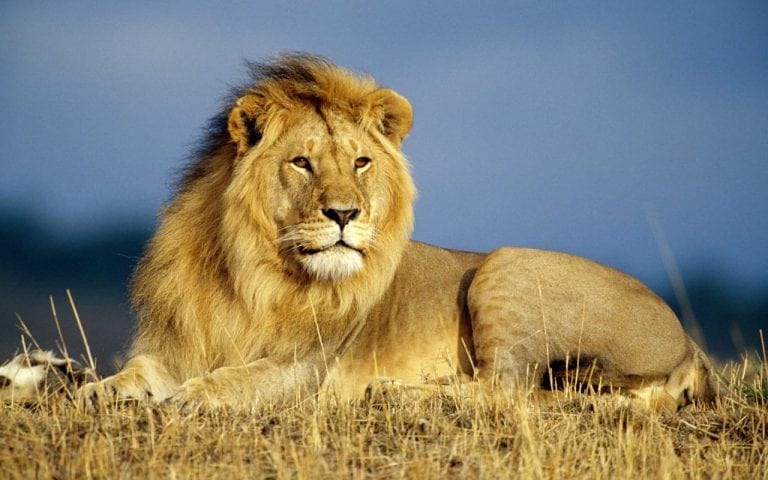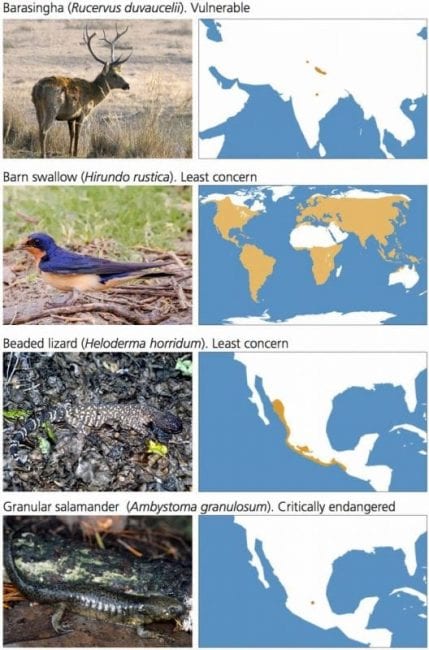Scientists warn of “biological annihilation” as Earth’s mass extinction accelerates
We share this planet; we do not own it.
WHAT HAVE YOU DONE FOR THE ANIMALS TODAY?
By Josh Varlin, wsws.org
Dateline: 12 July 2017

Lion Looking Into the Distance. All great African species are under extreme pressure, and lions are liable to vanish in less than a human lifetime. Humanity's self-centered footprint is inexorably killing untold millions of animals and wiping out thousands of species.
The study was coauthored by Gerardo Ceballos of the Instituto de Ecología at the Universidad Nacional Autónoma de México in Mexico City and by Paul R. Ehrlich and Rodolfo Dirzo of Stanford University’s Department of Biology.
The authors argue that while the extinction rate is already alarmingly high—including at least two vertebrate species per year for the past century—this does not tell the full story. Even if species have not yet gone extinct, their numbers and geographic distribution are decreasing dramatically, signaling an accelerating trend toward eventual extinction.
Detailed historical data from 1900 to 2015 is available for about 200 mammals, which are often major components of their ecosystems. Most of these key species are in crisis, even though they are not extinct: “In the 177 mammals for which we have detailed data, all have lost 30 percent or more of their geographic ranges and more than 40 percent of the species have experienced severe population declines (>80 percent range shrinkage).”

(Gerardo Ceballos et al., 2017, "Biological annihilation via the ongoing sixth mass extinction signaled by vertebrate population losses and declines," Proceedings of the National Academy of Sciences Online, www.pnas.org.)
Because population declines presage extinction, the study concludes that the planet has already begun its sixth mass extinction—the first since humans evolved.
The last mass extinction was at the end of the Cretaceous Period, about 66 million years ago, which saw the end of the dinosaurs, paving the way for mammals to dominate on land. The end-Cretaceous extinction was caused by an asteroid colliding with Earth, creating nuclear winter-like atmospheric effects.
The most catastrophic known mass extinction occurred at the end of the Permian Period (252 million years ago), and is known as “The Great Dying.” Approximately 70 percent of terrestrial species died during this cataclysmic event, which is thought to have occurred due to massive volcanic eruptions.
The fact that PNAS, one of the top science journals worldwide, published an article raising the possibility of events along the lines of “The Great Dying” is a sign that the ecological crisis is far advanced.
The paper, which is only about five pages long, not counting graphs or references, uses the word “annihilation” six times, “catastrophic” twice and a variety of “decimation” three times. Ceballos told the Atlantic that such frank language is warranted. “It would be alarmist if we didn’t have the data,” he said. “Now it would be irresponsible on our part to not use strong language. I wish we could say we are wrong but unfortunately, this is what is happening.”
The breakthrough made by Ceballos, Ehrlich and Dirzo is their thorough examination of populations, rather than staying at the level of species. A population is a group of individuals separated from other populations, usually by geography. Each species is made up of one or more populations.
If a species is losing several key populations but its overall numbers have not collapsed, it often will not be recognized as being in crisis. However, if a species is atomized into disparate, isolated populations, with its overall habitat shrinking, that makes its eventual extinction more likely.
In other words, the loss of each population of a species is one major step toward its overall extinction, unless measures are taken to restore the population and reverse the crisis.
Because most studies focus on extinction and not the loss of populations, they understate the scale of the crisis. Not only is the decline in populations a prelude to a significant number of extinctions, but the pace of population loss is accelerating.
[dropcap]M[/dropcap]oreover, many species with decreasing populations are not yet recognized as being endangered. Of all land vertebrates with decreasing populations, about 70 percent have been recognized as endangered by the International Union for Conservation of Nature (IUCN). However, less than half of decreasing bird species are recognized as endangered by the IUCN.
Because of the complexity of the environment, removing even a seemingly minor population or species can severely impact other species—if enough species go extinct, it can damage whole ecosystems. Human life as we know it relies on an increasingly strained ecological balance, and may be impossible if biodiversity is reduced too much. The loss of this dynamic balance, once it reaches a certain point, can cascade into a catastrophic, possibly irreversible collapse.
The study identifies “the proximate causes of population extinctions” as “habitat conversion, climate disruption, overexploitation, toxification, species invasions, disease and (potentially) large-scale nuclear war—all tied to one another in complex patterns and usually reinforcing each other’s impacts.”
These factors are all caused or greatly exacerbated by humans’ unplanned and irrational interaction with the environment, rooted in the subordination of all social and economic life to private profit. It is worth noting in this context the mention of the potential environmental consequences of a nuclear war, which could be set off by any number of conflicts around the world caused by the division of the world into competing capitalist nation-states.
The authors identify “the ultimate drivers of those immediate causes of biotic destruction” as “human overpopulation and continued population growth, and overconsumption, especially by the rich.” One need not agree that population growth itself is the problem to recognize that human activity, without scientific planning, places immense strains on the environment.
Ceballos, Ehrlich and Dirzo conclude their paper by noting that “the window for effective action is very short, probably two or three decades at most.” Their article should serve as a notice that the clock is ticking for humanity to establish socialism—a social system in which life is scientifically organized around human need, including the need to be in harmony with the natural environment. Only through the conscious effort to place humanity on such a rational basis can ecological collapse be prevented.
SELECT COMMENTS
-
Dorota • 14 hours ago Quote from the article:"...the ultimate drivers of those immediate causes of biotic destruction, namely, human overpopulation and continued population growth, and overconsumption, especially by the rich. These drivers, all of which trace to the fiction that perpetual growth can occur on a finite planet, are themselves increasing rapidly." If you disagree with the scientists on the fact that the population growth is "the ultimate driver of biotic destruction", what is your argument to counter the statement that the perpetual growth canot occur on a finite planet, since one is tied to the other?
Josh Varlin Dorota • 4 hours ago I agree that population growth under capitalism is one of the major causes of environmental degradation, including the extinction of species noted in the WSWS article.
Under the scientific and democratic planning of the economy, it will be possible for humanity to stay at the same population or even increase while dramatically reducing environmental impact. One small example would be more efficient farming techniques, allowing for more food without increasing the percentage of arable land being farmed. Another would be a massive investment in renewable energy, allowing for humanity to generate electricity without the use of fossil fuels.
These are complicated questions that will have to be decided by the working class on the basis of the highest scientific knowledge and technique. Only on this basis can humanity reduce its impact on the environment, and reverse the damage.
jlfittro Dorota • 9 hours ago Doesn't this article specify "unplanned" growth, capitalism and profit above all as the root problem? Aren't the richest, and least populated , societies guilty of greatest misuse of resources. Population is a problem but it is complex, as this scientific study itself points out that you have to look further than total number of species, and look at populations of species. Can we look at populations of human species in the same way. What groups do most harm and why? Isn't the root problem the socio- economic system of capitalism we live under? Isn't this elaborated by wsws continually? Am I missing something in your question? Sincere inquiry.
Josh Varlin jlfittro • 4 hours ago Hi jlfittro,
My article does indeed specify unplanned growth and capitalism as being the problems. The scientists' article, which Dorota is quoting, argues that human overpopulation is the problem.
The WSWS does place capitalism at the center of the problem, not human population as such. Humans obviously have an impact on the environment, and, all else being equal, having more people will result in a higher impact of the environment.
However, scientific development and economic planning that is both scientific and democratic will allow for humans to reduce their environmental impact. One example would be a massive investment in clean, renewable energy (like wind and solar), allowing for power without using fossil fuels.
 The authors cite human overpopulation and overconsumption in their study as the primary reasons driving the loss of individual members of various species, as well as the loss of species (two vertebrate species go extinct every year, on average), and call to undo “the fiction that perpetual growth can occur on a finite planet”. Particularly hard hit have been the mammals of south and southeast Asia, where all the large-bodied species of mammals analyzed lost more than 80% of their geographic ranges. Wildlife is swiftly dying out due to habitat destruction, overhunting, toxic pollution, invasion by alien species and climate change. HealthcareMenu http://healthcaremenu.net/2017/07/11/earth-undergoing-sixth-mass-extinction-as-humans-spur/
The authors cite human overpopulation and overconsumption in their study as the primary reasons driving the loss of individual members of various species, as well as the loss of species (two vertebrate species go extinct every year, on average), and call to undo “the fiction that perpetual growth can occur on a finite planet”. Particularly hard hit have been the mammals of south and southeast Asia, where all the large-bodied species of mammals analyzed lost more than 80% of their geographic ranges. Wildlife is swiftly dying out due to habitat destruction, overhunting, toxic pollution, invasion by alien species and climate change. HealthcareMenu http://healthcaremenu.net/2017/07/11/earth-undergoing-sixth-mass-extinction-as-humans-spur/






